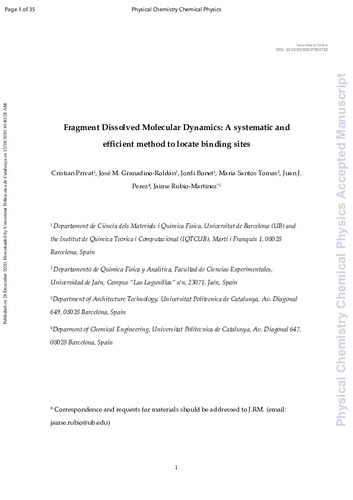Mostra el registre d'ítem simple
Fragment dissolved molecular dynamics: a systematic and efficient method to locate binding sites
| dc.contributor.author | Privat, Cristian |
| dc.contributor.author | Granadino, Jose Manuel |
| dc.contributor.author | Bonet Ruiz, Jordi |
| dc.contributor.author | Tomás Belenguer, María Santos |
| dc.contributor.author | Pérez González, Juan Jesús |
| dc.contributor.author | Rubio Martínez, Jaime |
| dc.contributor.other | Universitat Politècnica de Catalunya. Departament de Tecnologia de l'Arquitectura |
| dc.contributor.other | Universitat Politècnica de Catalunya. Departament d'Enginyeria Química |
| dc.date.accessioned | 2022-04-01T12:04:06Z |
| dc.date.available | 2022-05-02T00:25:28Z |
| dc.date.issued | 2021 |
| dc.identifier.citation | Privat, C. [et al.]. Fragment dissolved molecular dynamics: a systematic and efficient method to locate binding sites. "Physical chemistry chemical physics", 2021, vol. 23, núm. 4, p. 3123-3134. |
| dc.identifier.issn | 1463-9076 |
| dc.identifier.uri | http://hdl.handle.net/2117/365204 |
| dc.description.abstract | Diverse computational methods to support Fragment-based drug discovery (FBDD) are available in the literature. Despite their demonstrated efficacy to support FBDD campaigns, they exhibit some drawbacks such as protein denaturation or ligand aggregation that have not been yet clearly overcome in the framework of biomolecular simulations. In the present work, we discuss a systematic semi-automatic novel computational procedure, designed to surpass these difficulties. The method, named fragment dissolved Molecular Dynamics (fdMD) utilizes simulation boxes of solvated small fragments, adding a repulsive Lennard-Jones potential term to avoid aggregation, which can be easily used to solvate the targets of interest. This method has the advantage of solvating the target with a low number of ligands, thus preventing this way denaturation of the target, while simultaneously generating a database of ligandsolvated boxes that can be used in further studies. A number of scripts are made available to analyze the results and obtain the descriptors proposed as a means of trustfully discard spurious binding sites. To test our method, four Test cases of different complexity have been solvated with ligand boxes and four molecular dynamics runs of 200 ns length have been run for each system, which have been extended up to 1 µs when needed. The reported results point that the selected number of replicas are enough to identify the correct binding sites irrespective of the initial structure, even in the case of proteins having several close binding sites for the same ligand. We also propose a set of descriptors to analyze the results, among which, the average MMGBSA and the average KDEEP energies emerge as the most robust ones. |
| dc.format.extent | 12 p. |
| dc.language.iso | eng |
| dc.publisher | Royal Society of Chemistry (RSC) |
| dc.subject | Àrees temàtiques de la UPC::Física |
| dc.subject.lcsh | Molecular dynamics |
| dc.title | Fragment dissolved molecular dynamics: a systematic and efficient method to locate binding sites |
| dc.type | Article |
| dc.subject.lemac | Dinàmica molecular |
| dc.contributor.group | Universitat Politècnica de Catalunya. GBMI - Grup de Biotecnologia Molecular i Industrial |
| dc.identifier.doi | 10.1039/D0CP05471B |
| dc.description.peerreviewed | Peer Reviewed |
| dc.relation.publisherversion | https://pubs.rsc.org/en/content/articlelanding/2021/CP/D0CP05471B#!divAbstract |
| dc.rights.access | Open Access |
| local.identifier.drac | 31292996 |
| dc.description.version | Postprint (author's final draft) |
| local.citation.author | Privat, C.; Granadino, J.; Bonet, J.; Tomas, M.; Perez, J.; Rubio, J. |
| local.citation.publicationName | Physical chemistry chemical physics |
| local.citation.volume | 23 |
| local.citation.number | 4 |
| local.citation.startingPage | 3123 |
| local.citation.endingPage | 3134 |
Fitxers d'aquest items
Aquest ítem apareix a les col·leccions següents
-
Articles de revista [190]
-
Articles de revista [559]
-
Articles de revista [2.226]


